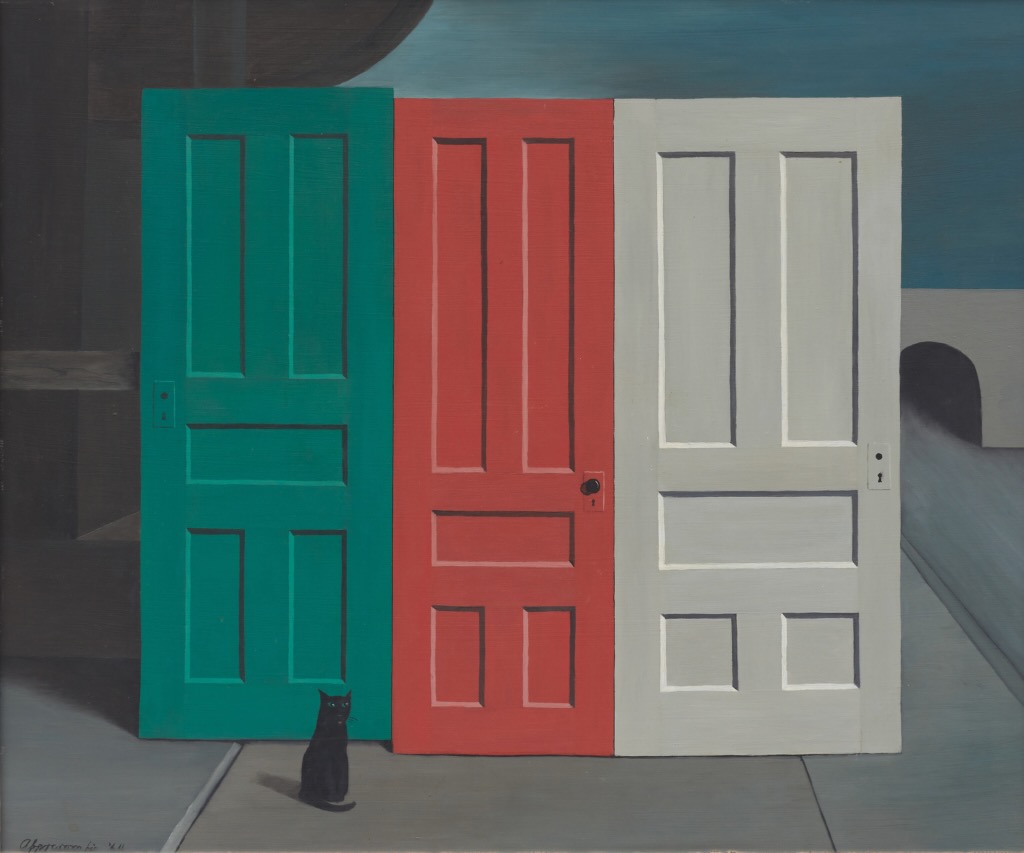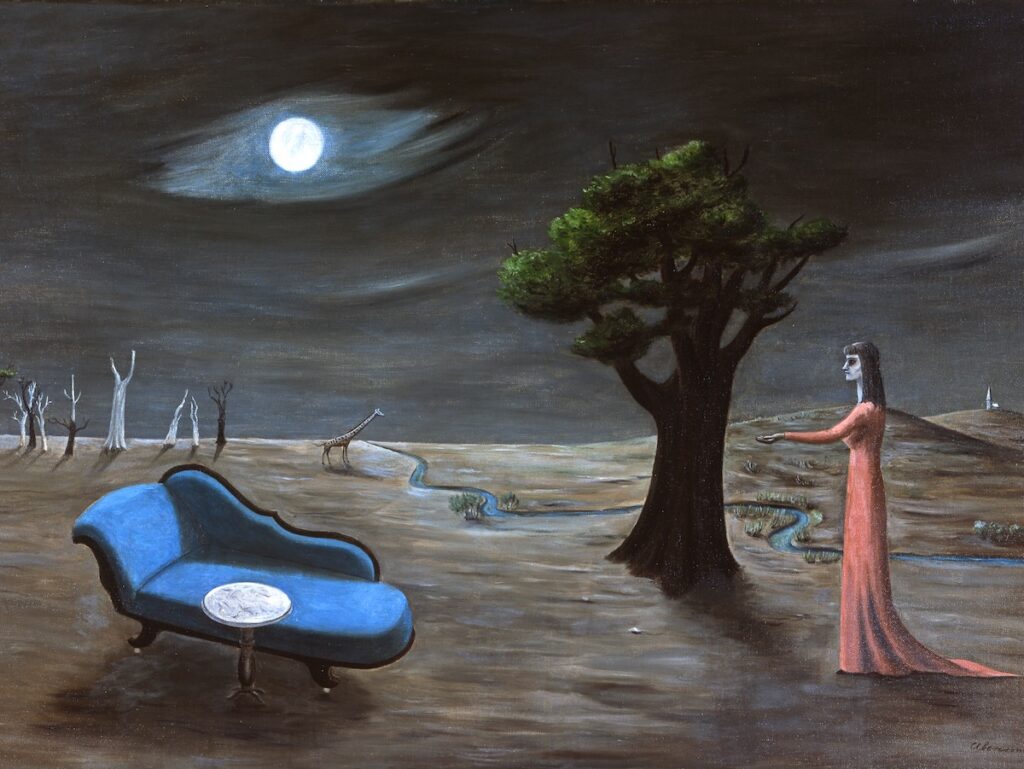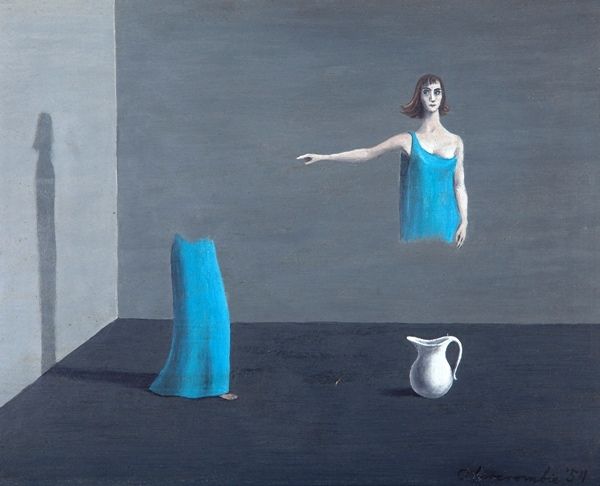People called her the “jazz witch” or the “bohemian queen.” She wore a sultry leopard-print coat, married twice and divorced twice—once to an ex-convict—but had lasting housemates in her cats, Toddy and Kalahari. Painter Gertrude Abercrombie, the woman behind all of these epithets, used a palette of dark colors. But her paintings still have a sense of whimsy to them. With a life like hers as inspiration, how could they not? Under someone else’s vision, navy, beige, and black could feel like a landscape of sadness.
But Abercrombie, whose work is on display through June 5 at the Carnegie Museum in The Whole World is a Mystery, instead creates a dreamscape that plays with our associations with dark and light, inside and outside, and self and other. There is no interior and exterior, only everything that is. Horses and owls come into the bedroom and lavish futons sit abandoned in the middle of fields of oats. Abercrombie saw her work as at the crossroads of her dreams and her interpretations of reality.
Gertrude Abercrombie’s Bohemian Dreams
The Whole World is a Mystery is a project of Henry J. Heinz II Director of the Carnegie Museum of Art Eric Crosby and the Colby College Museum of Art’s Lunder Curator of American Art, Sarah Humphreville. Both have had a long professional interest in Abercrombie, a bohemian figure born in 1909 whose close friendships with black Chicago jazz musicians, lack of interest in motherhood or “settling down,” and insistence on her work above all else made her unconventional for her time. The Whole World is a Mystery as a retrospective is a full-circle moment, as one of Abercrombie’s earliest museum shows outside of Chicago was at the Carnegie Institute in 1936.
Abercrombie’s life was stranger than fiction, born to two traveling opera singers who moved frequently before settling in Aledo, Illinois. The accompanying publication to The Whole World is a Mystery features a detailed timeline of her life and is well worth looking at in the exhibition space (the Carnegie provides a table to sit and read beside Abercrombie’s paintings with a jazz soundtrack). Another famous Gertrude, one Miss Gertrude Stein, served as mentor. Jazz musician Dizzy Gillespie was a friend and inspiration, whom she made work dedicated to. She detested racial injustice and made some of her most famous paintings, the Demolition Doors series, in response to demolished buildings on Chicago’s South Side, where her friends and neighbors’ homes were bulldozed to make way for university buildings and condos.

Abercrombie Lived Life on Her Own Terms
In A Terribly Strange Tree (1949), a sliver of cyan takes us out of Abercrombie’s shrouded dreamscape and into the normal world of blue skies and four-walled spaces. Yet, looking at Abercrombie’s paintings, one would rather stay inside her dreams. It would be easy to call her work “surreal” in the vein of Magritte or Dali, but to do so might dismiss her interest in reality. She called Magritte her “spiritual daddy,” and said that “Surrealism is meant for me because I am a pretty realistic person but I don’t like all I see. So I dream that it is changed. Then I change it to the way I want it. It is almost always pretty real. Only mystery + fantasy have been added. All foolishness has been taken out. It becomes my own dream. Others may not get it. Or dig it.”
One can almost feel in her work the sense that Abercrombie really is content that others might not “get” what she has to say. Gertrude Stein advised her to be a neat, confident artist and not to veer into blurry, smudge-y composition. Her paintings One of her most complex paintings is Search for Rest (195!). That painting shows another tear in the grey cloud cover, a full moon inside of it, mirroring an Iris and pupil. A blue couch sits below it, the moon reflected in its blue fabric as if it were water.

Autobiographical Surrealism
Split Personality (1954) shows a woman’s torso above a vase, her hand extended towards her disembodied legs. Yet, her shadow shows a whole. This is one of the show’s most poignant pieces, tiny in size but compelling in impact.
Even without the context of Abercrombie’s life, there appears a struggle between domesticity and freedom, marginalization and abundance. Ladders, stairs and pathways feature prominently in the work. Her paintings deal with the contradictions and absurdity of womanhood, using images to convey the indignations and griefs that feel like words fail to express them. One moment that stood out to me was that in Trees of Life (Parts 1 & 2) (1949), in a world where a ladder can go the moon and a lion can play checkers, the female nude figure has body hair. This is what often might be praised as a “real” depiction of a female body over one from the male imagination.

Abercrombie’s paintings feel like they could be both from hundred years ago or from yesterday. Her open-minded-ness and sense of social justice as not just a set of political principles but as a personal code of ethics to bring into her relationships are something to live by. We see echoes of Abercrombie in some contemporary paintings in the Carnegie’s collection like Nicole Eisenmann’s Ariana’s Salon (2013). or in local painters like Southern-influenced neo-surrealist Jamie Earnest, recently on view in Nearing Each Other in the museum’s Forum gallery. Abercrombie’s work, like Langston Hughes’ poetry, reminds us that a better world and a better life starts by giving ourselves the freedom to dream what does not yet exist.
Story by Emma Riva
Cover photo courtesy of KARMA
Subscribe to TABLE Magazine’s print edition.
